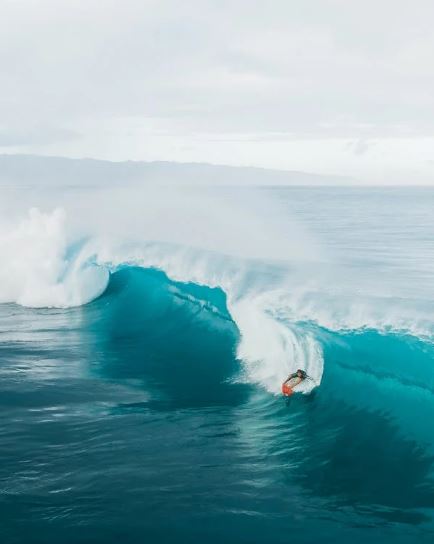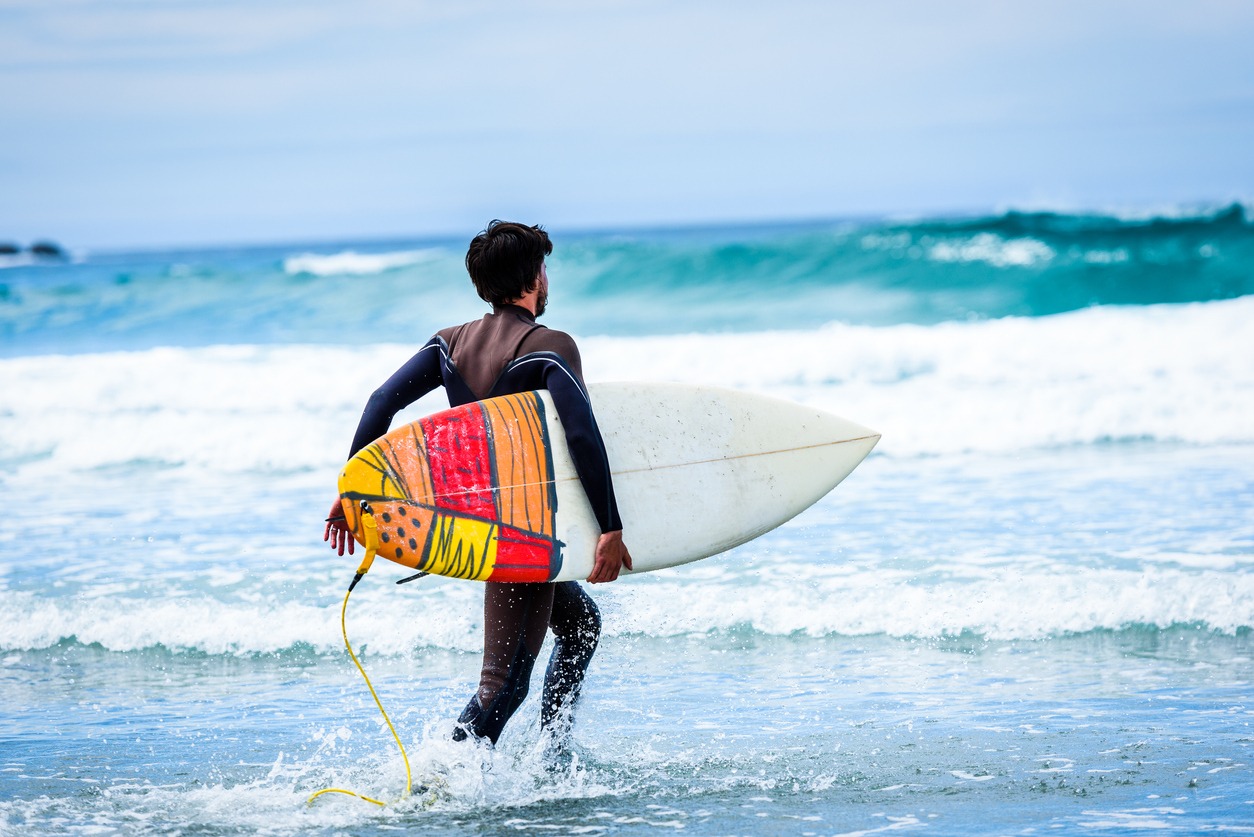Big wave surfing is a type of surfing where experienced surfers paddle into waves that are at least 20 feet (6.2 m) high or are towed into them on surf boards called “guns” or “towboards.” The size of the wave and the way the surfer gets to the wave affects the size of the board he or she needs to ride it. A bigger, longer board is more stable and makes it easier to paddle fast enough to catch a wave. However, it makes it harder to turn and slows down surfing speed.
In 1992, big wave surfers like Laird Hamilton and Darrick Doerner came up with a new sport called “tow-in surfing,” which was a mix of two sports. Even though many riders still do both, they are still very different sports. For this type of surfing, a jet ski pulls the surfer into big waves, giving them the speed they need to ride. Tow-in surfing also changed the size of boards. Surfers could get rid of their heavy 12-foot boards and switch to 7-foot boards that were faster and easier to control in waves over 30 feet high. By the end of the 1990s, surfers could use tow-in surfing to ride waves that were more than 50 feet high.
Tow-in or Paddle-in: Which Is Better?
Before the advent of tow-in big wave surfing in the 1990s, surfers caught big waves the same way they caught small ones: by paddling down the face. Surfers’ ability to ride large waves was constrained by the drop’s steepness and the wave’s velocity. Because of the extreme pitch of the wave face, surfers could get “pitched” by the lip of the wave or free fall down the face (before or after getting to their feet). Another limiting factor for surfboard design was the speed of the waves: An ideal surfboard must be long and buoyant, but it must also have an adequate rail edge and be flexible enough to maneuver through a wave’s swell without losing its momentum. As far back as the early 1990s, Laird Hamilton pioneered tow-in surfing on the island of Maui, Hawaii, where a surfer is towed into the waves on jet skis at much higher than paddling speeds. Because of the smaller boards and higher speeds that tow-in surfers are able to use, they’ve made significant progress over traditional paddle-in big wave surfing. They can now surf waves up to 18 meters in height, which is more than twice as big as what paddlers can handle. Tow-in surfing has opened up previously unreachable big wave spots, such as Oahu’s Outside Log Cabins, Maui’s Jaws, New Zealand’s Green Island, and the Cortez Bank off the coast of San Diego, California, thanks to the speed and steepness of the waves.
Purity has been compromised by some paddle-in surfers’ use of towins. The first tow-in contest at Jaws was held on the same day as “the Eddie” at Waimea Bay on January 12th, 2001, highlighting the rivalry between paddle-in and tow-in big wave surfing. Traditionalists and “Eddie” organizer George Downing, who believed that his contest should take precedence, were miffed that some contestants planned to enter both events and were forced to choose between the two.
When the Billabong Odyssey, an annual contest for huge waves, first debuted in 1997, it offered a cash prize for the biggest wave surfed and captured in still or moving pictures, but the contest was not site-specific. Big wave surfers were pitted against one another for the first time in a variety of settings and conditions. Tow-in surfers have won the largest wave award every year but 1997 except for the first year, so separate “Monster Paddle-in,” “Monster Tube,” “Best Overall Performance,” and “Girls Best Overall Performance” awards have been added to reflect the contemporary diversity of big wave surfing traditions in the modern world.
Places to Surf Big Waves
1. Mavericks, in California
If you want to surf big waves in the United States, go to the Mavericks, which is near Half Moon Bay in California. Surfers who know what they’re doing can ride 20-foot waves, but some waves can reach 100 feet. Mark Foo and Sion Milosky, two well-known surfers, died here.
2. Banzai Pipeline
The Banzai Pipeline, which is off the north shore of Oahu, Hawaii, is a dangerous place to surf for both locals and tourists who want to try something new. In the winter, huge waves hit a sharp, shallow reef, making some of the world’s most dangerous waves. Since the 1980s, seven surfers have died while riding the Pipeline.
3. Peahi, Hawaii
Jaws, Maui’s North Shore. Jaws, which is also called Peahi, has some of the most dangerous and beautiful waves on earth. The break, where 50-foot waves and bigger come almost every year, is almost exclusively a tow-in spot, but some rebel surfers paddle in by hand. Twenty-one pros have been asked to compete in a paddle-in event at Jaws between December 7 and March 15 this winter. On a nearby high bluff, people can get a great view of the action. But go early, because there will be a long line of people waiting for the best spots to watch. Also, bring binoculars because the waves crash into the shore almost a mile away.
4. Waimea Bay is on Oahu’s North Shore
Big-wave surfing started here, thanks in large part to Greg Noll’s brave ideas in the 1950s. Extreme surfers’ idea of what “big” means has changed since the beginning, but Waimea still holds its own. Waves as high as 50 feet can happen here, which makes all but the best surfers leave the water. When conditions are right, the Quicksilver Eddie Aikau Invitational brings together the best surfers. During big-swell times, there are a lot of people on the beach, and you may have to fight to get a good view. Arrive early.
5. Ireland, Mullaghmore Head
Mullaghmore Head comes to life during winter storms in the North Atlantic, which is a long way from the Pacific shores where big-wave legends and history are set. The place has waves that are so big that surfing is mostly done with the help of a jet ski. The Billabong Tow-In Session at Mullaghmore actually started on November 1 and will go on until February 2013. What does Mullaghmore Head look like? Satellite measurements show that the waves here were 50 feet high on March 8, 2012. From an elevated spot on a grassy headland, you can watch the show. Prepare for cold, windy weather if you decide to go.
6. Ghost Trees in California’s Monterey Peninsula
This break is at its best when the waves are like those at Mavericks, which is only a three-hour drive north. Ghost Trees is a new place for big-wave surfers to go. Don Curry, a veteran surfer, says that he first saw it being surfed in 1974. Before it became well-known and killed Peter Davi, a pro surfer and one of the first people to surf at Mavericks, which is close by, it was a long time. Ghost Trees is one of the best places to watch people surf. Waves that can reach 50 feet or more break just a football field from the beach.
Surfboards for Riding Big Waves
Big wave surfers are only interested in a 6- to 12-foot-long “gun.” A gun is thicker than a shortboard, but it is much narrower on both ends. The rails will touch each other more when the frame is narrow.
The round-pin tail is essential because it lets surfers dig deep into a big wave to start making fast turns. Long, heavy boards are strong, so they can also handle chop well. And finally, the stick should have a strong finish so that it is less likely to break when you fall.
Shane Dorian rides a board that is 11’3″ long and 4″ thick. It has double glassing to make it heavier and four fins. Naxto Gonzalez, a Basque surfer, changes between a 10’4″, a 9’6″, and a 7’4″.
Big Wave Surfing is all About the Preparation
Just standing up uses more than 60 of the body’s muscles. So just think about what it takes to ride an 8-foot-long board down a wave that would cover your house.
Big wave athletes still like to do underwater rock running because it helps them get better at breathing, strengthens their core, and builds the muscles they need to stay upright on their stick. But it doesn’t matter what you do as long as you put your body to the test every day and work out hard.
Yoga will keep the body flexible and also help the diaphragm get stronger. Yoga teaches the body to use air more efficiently, which is as important as it gets to be ready for those long hold-downs.
Keep in mind that a high-speed bail-out will knock a lot of air out of your body, so it’s important to be ready to be held underwater without much air. It’s all about telling your body to get ready for punishment while it’s not paying attention.
The next step is to get your mind ready, which can be by far the hardest. Freediving teachers will tell you that while you’re under, you shouldn’t try to guess how long it will be until you come back up. Time anticipation will cause stress, and stress will make your muscles tighten, which will use up oxygen, which is your best friend when you’re 20 feet under the ocean.
Conclusion
Surfing is not a sport that is easy to pick up. To make progress, you need a lot of time, effort, consistency, and faith.
An XXL wave has a lot of energy and makes it almost impossible to duck dive. When it breaks, a big wave can break bones, keep someone underwater for a long time, or even slam a surfer into the ocean floor. Even though it’s dangerous, it’s quite a sight to see surfers bravely take on waves this big.


